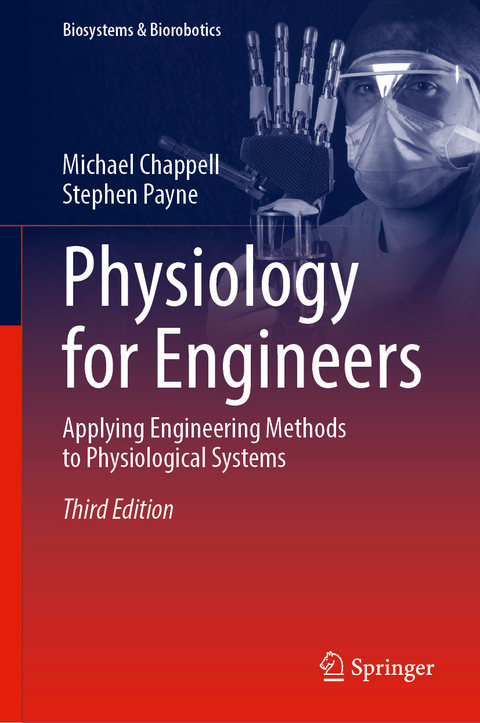
Physiology for Engineers
Springer International Publishing (Verlag)
9783031776380 (ISBN)
This book introduces both qualitative and quantitative aspects of human physiology through language and concepts familiar to engineers and other physical scientists. It looks at biological and physiological processes and phenomena, including a selection of mathematical models, showing how physiological problems can be mathematically formulated and studied. It also illustrates how a wide range of engineering and physics topics, including electronics, fluid dynamics, solid mechanics and control theory can be used to describe and understand physiological processes and systems. Throughout the text there are introductions to measuring and quantifying physiological processes using both signal and imaging technologies.
Physiology for Engineers describes the basic structure and models of cellular systems, the structure and function of the cardiovascular system, the electrical and mechanical activity of the heart and provides an overview of the structure and function of the respiratory and nervous systems. It also includes an introduction to the basic concepts and applications of reaction kinetics, compartmental modelling and its application to pharmacokinetics and tracer kinetics.
The book is of interest to final year biomedical engineering undergraduates and graduate students alike, as well as to practising engineers new to the fields of bioengineering or medical physics. This new edition is fully revised and updated with two completely rewritten chapters on compartmental modelling, demonstrated in application to pharmacokinetics, and multi-scale modelling demonstrated by how to go from "from cells to tissue" in describing physiological systems. The book contains interleaved exercises to make the book even more useful for instructors and students for a one-semester course.
Michael Chappell is Professor of Biomedical Imaging in the Sir Peter Mansfield Imaging Centre and School of Medicine, University of Nottingham. He is also Chief Scientific Officer for Quantified Imaging and Honorary Research Fellow at the Wellcome Centre for Integrative Neuroimaging, University of Oxford. Previously he was Associate Professor of Engineering Science at the Institute of Biomedical Engineering, University of Oxford. Michael has a background in the mathematical modelling of physiology, Bayesian inference methods, machine learning techniques, and the development of image analysis algorithms. Much of his recent research has focused on the quantitative spatial mapping of physiological quantities, such as perfusion, from medical imaging devices for use in clinical research and practice. Michael read Engineering Science in Oxford, specialising in information engineering topics and completing a project on the detection of landmines. He completed a doctorate on SCUBA diving, primarily using mathematical models to explore the development of bubbles from dissolved gases under decompression in the body - the resulting sickness commonly referred to as 'the bends'. Finally, he found his way into magnetic resonance imaging, working at the interface between physical and medical sciences. Michael is co-author of Physiology for Engineers, the author of the Principles of Medical Imaging for Engineers and is a series editor for the Oxford Neuroimaging Primers.
Stephen Payne is an Professor of Engineering Science at the Institute of Applied Mechanics, National Taiwan University, Taiwan. Stephen leads the Cerebral Haemodynamics Group, focusing on modelling blood flow and metabolism in the brain, which is particularly important in the context of diseases such as stroke and dementia. Another of the group's key areas is cerebral autoregulation - the mechanism that maintains blood flow almost constantly in response to changes in blood pressure. Stephen has worked in physiological modelling for over 20 years. Having entered the field of biomedical engineering before it was available even as an undergraduate option course, he has seen first-hand how difficult it can be to learn about physiology in a way that makes it amenable to mathematical treatment, such as mathematical modelling, without good introductory guides. Stephen is also the author of two related books on cerebral autoregulation and cerebral blood flow and metabolism.
Cell Structure and Biochemical Reactions.- Cellular Homeostasis and Membrane Potential.- The Action Potential.- Cellular Transport and Communication.- Pharmacokinetics.- Tissue Mechanics.- Cardiovascular System I: The Heart.- Cardiovascular System II: The Vasculature.- Respiratory System.- Nervous System.- Solutions.
| Erscheinungsdatum | 14.06.2025 |
|---|---|
| Reihe/Serie | Biosystems & Biorobotics |
| Zusatzinfo | IX, 193 p. 80 illus., 46 illus. in color. |
| Verlagsort | Cham |
| Sprache | englisch |
| Maße | 155 x 235 mm |
| Themenwelt | Informatik ► Weitere Themen ► Bioinformatik |
| Medizin / Pharmazie ► Physiotherapie / Ergotherapie ► Orthopädie | |
| Studium ► 1. Studienabschnitt (Vorklinik) ► Physiologie | |
| Technik | |
| Schlagworte | Bioengineering • Biological Systems • biomedical engineering • Cardiovascular System • cell models • Multi-scale Models • Pharmacokinetic Models • physiological systems • Respiratory System |
| ISBN-13 | 9783031776380 / 9783031776380 |
| Zustand | Neuware |
| Informationen gemäß Produktsicherheitsverordnung (GPSR) | |
| Haben Sie eine Frage zum Produkt? |
aus dem Bereich


